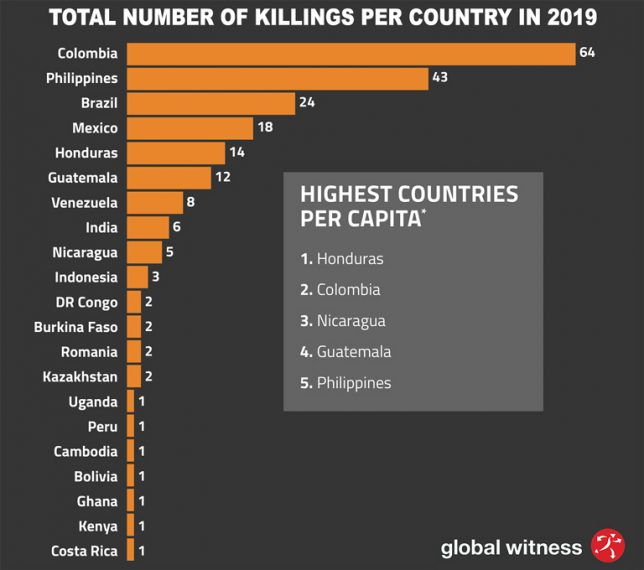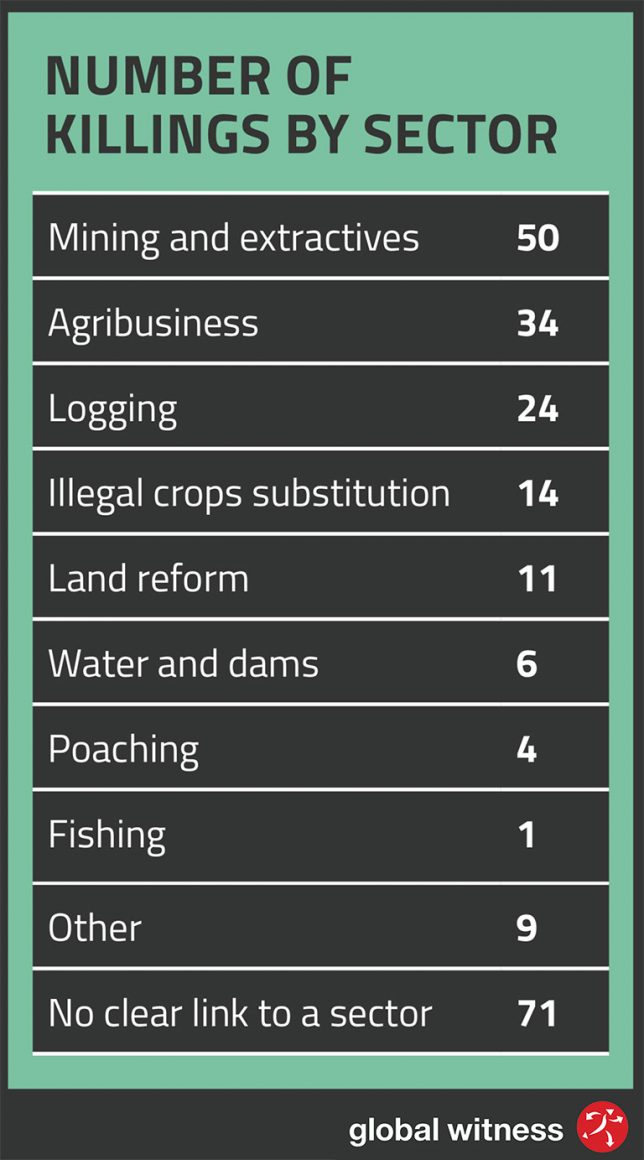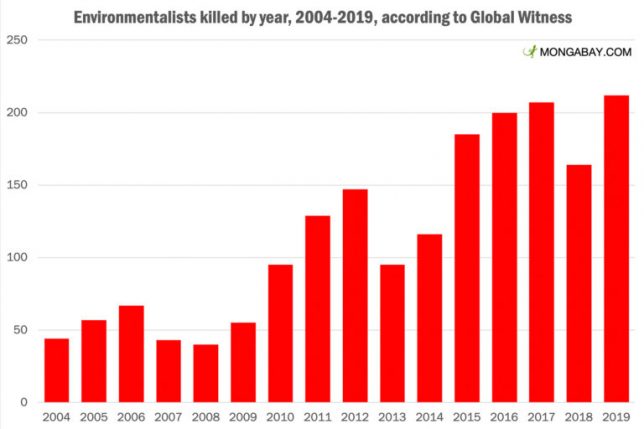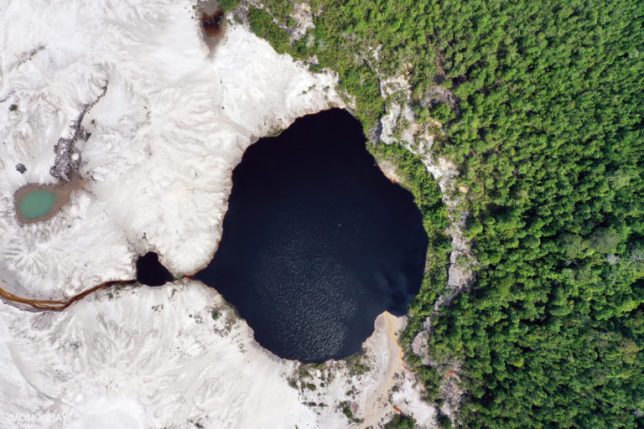2019 was the deadliest year ever for environmental activists, watchdog group says
Global Witness says that activists on the frontline of the climate crisis are facing more violence than ever before.
By Ashoka Mukpo on July 29, 2020
Mongabay Series: Global Forests
- In a new report, the watchdog group says that at least 212 environment and land defenders were killed across the world in 2019.
- The deadliest countries were Colombia and the Philippines, with 64 and 43 killings respectively.
- Despite making up only 5% of the world’s population, representatives of Indigenous communities accounted for 40% of those killed.
- Killings related to agribusiness jumped by 60%, to 34 in 2019 – researchers say as consumption of commodities like beef and palm oil increases, so too will deadly conflict over land.
2019 was the deadliest year on record for environmental activists, according to a new report by the advocacy watchdog Global Witness. In total, the group says that at least 212 people were killed across the world in retaliation for their defense of land and the environment, with those representing Indigenous communities bearing a disproportionate brunt of the violence.
Many of the killings were linked to battles over control of forests that are critical to the global fight against climate change, said Chris Madden, a senior campaigner at Global Witness.
“Looking at the cases that we’re seeing and the issues these people are working against, they’re often the very same causes of climate breakdown,” he told Mongabay in an interview. “So that’s why we’re saying they’re at the front line of the climate crisis.”
Topping the list of the deadliest countries for environmental defenders in 2019 were Colombia and the Philippines, with 64 and 43 killings respectively. In Colombia, the figure was more than double the number who were murdered in 2018. Overall, the most dangerous region for defenders was Latin America, which saw two-thirds of the global death toll, with the Amazon alone accounting for 33 deaths.


Despite only making up 5% of the world’s population, activists representing Indigenous communities, who are often on the front lines of conflict over forests and land, comprised 40% of those killed.
In Colombia, the 2016 peace agreement signed between the government and the leftist guerrilla group FARC is causing a scramble for control over lucrative resources left behind in the group’s wake.
As FARC insurgents demobilize under the terms of the agreement, paramilitary and other criminal groups are rushing in to fill the void, with Indigenous communities suffering as a result of the power struggle. Those communities accounted for half of the documented killings in the country despite representing less than 5% of Colombia’s population.
In late May, Mongabay published video of paramilitaries firing assault rifles into an Indigenous Emberá town and forcing members of the community to flee by canoe.
When environmental defenders are killed in Colombia, the courts rarely deliver justice. According to Global Witness, nearly nine in 10 murders of human rights activists in the country do not lead to a conviction.
Elsewhere, the deaths of activists have been linked to intimidation and violence carried out on behalf of repressive governments. Killings in Honduras jumped from four in 2018 to 14 in 2019, giving it the highest per capita rate of any country analyzed by Global Witness. In the Philippines, 2019’s toll brings the total since Rodrigo Duterte took office in mid-2016 to 119 — almost double the figure for the comparable period before his election.
A number of killings in the Philippines have come directly at the hands of government forces or groups loyal to it, including that of a leader of the Manobo Indigenous group, who reportedly died during an aerial bombardment by the Filipino military last year. The Manobo have long been engaged in a campaign to prevent encroachment into the Pantaron mountain range by loggers and mining companies.
The Armed Forces of the Philippines later posted a photograph of his body online, saying he was killed during a clash with local communist militants. According to Global Witness, this follows a pattern of activists and environmental defenders being “red-tagged,” or accused of holding communist sympathies and providing support for rebel groups.
“In the Philippines, state forces are implicated in quite a number of cases,” Madden said.

Overall, data shared with Mongabay by Global Witness show that the majority of killings globally are carried out by unknown assailants, accounting for 65 of the deaths. Forty were traced to hit men, 22 to paramilitary forces, and 17 to armed forces or police. Others were connected to landowners, criminal gangs, and private security guards.
In recent years, agribusiness has been linked to a rising number of retaliatory murders of land rights activists. In 2019, 34 such killings were recorded, an increase of more than 60% from the previous year. As global consumption rises, Madden says that violent conflict over land that can be used to produce palm oil, soy, cattle, and other commodities is likely to spike as well.
“At the global level, with increased consumption, we are seeing that these industries do have to keep expanding into ever more remote or different areas,” he said. “That’s what we’re seeing at the Amazon at the moment with agribusiness and logging ramping up again, and it’s playing out in various places across the world.”

Madden adds that as troubling as the numbers are, they are also likely to be significantly underestimated. The methodology Global Witness uses to verify killings of environmental and land defenders is strict, drawing on media reports as well as those from the group’s local partners. In some parts of Africa, for example, retaliation against local and Indigenous activists can be hard to track.
Tabitha Netuwa of DefendDefenders, a Uganda-based human rights organization that provides support to activists in East Africa, agrees that the true figure is almost certainly higher.
“It is an underestimate – the shrinking civic space for [human rights defenders] to operate is making reporting about human rights violations a challenge. In addition, many of these violations happen in areas far removed from the capitals where accessibility is a challenge and many [human rights defenders] working in those remote areas face reprisals for speaking out,” she told Mongabay in an email.
Four activists from sub-Saharan Africa were represented in the total, with one each from Kenya and Ghana along with two from the Democratic Republic of the Congo, including Joël Imbangola Lunea, who was allegedly murdered by a security guard working for the Canadian palm oil company Feronia Inc.
According to Madden, while some governments, corporations and financial institutions have taken steps to protect local activists, more needs to be done.
“I think that governments in particular in the EU, U.S., and global north have a particular role to play in strengthening requirements around what companies need to do in these situations,” he said. “So making sure they have to do full due diligence of the human rights impacts throughout their whole supply chain.”
Note: This story has been amended to include a quote from Tabitha Netuwa of DefendDefenders.
CITATION: Global Witness. Defending Tomorrow: The climate crisis and threats against land and environmental defenders. July 2020.
